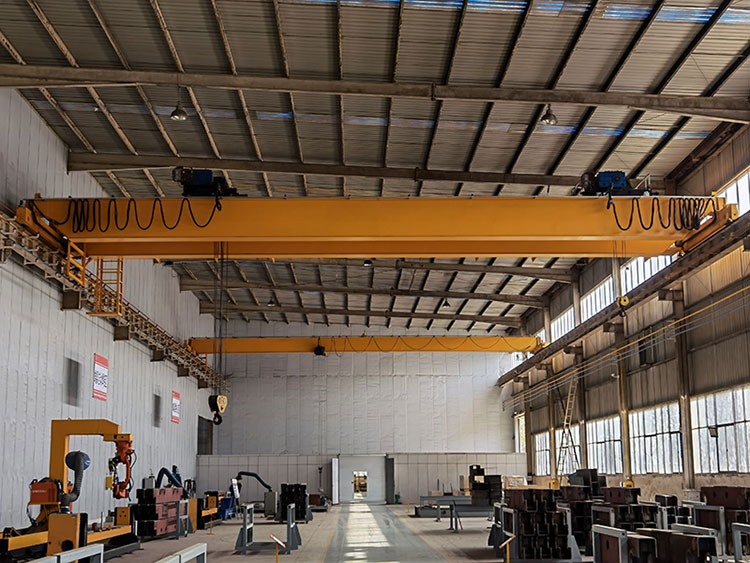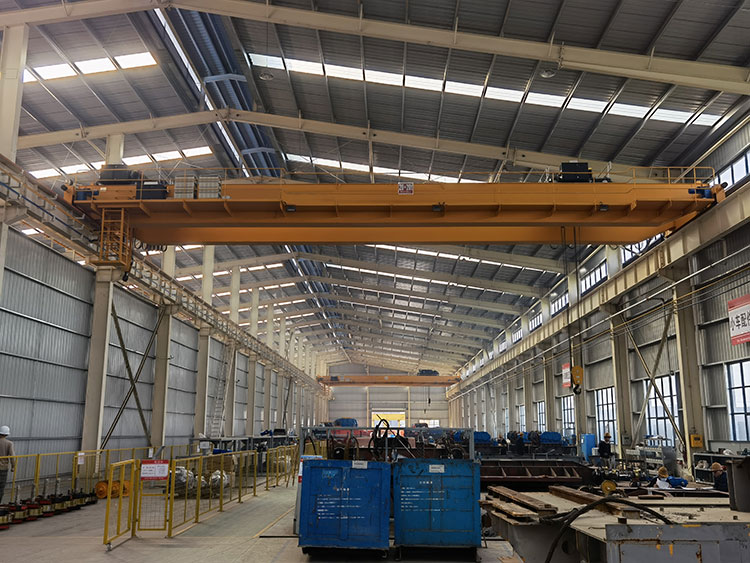An Overhead Traveling Crane (commonly referred to as an EOT crane) is a type of lifting equipment used extensively in industrial environments to move heavy loads. These cranes are designed to operate in facilities where materials or components need to be transported from one point to another within a building. The efficiency and versatility of overhead traveling cranes make them an essential part of various industries, including manufacturing, construction, steel mills, power plants, and warehouses.
In this article, we will explore what an overhead traveling crane is, how it works, its components, different types, and the advantages it offers to businesses. Understanding the functionality and benefits of these cranes can help industries improve their material handling processes and enhance operational efficiency.

What is an Overhead Traveling Crane?
An Overhead Traveling Crane is a crane system that is mounted above ground level, typically on runways or girders that are fixed to the structure of a building. The main purpose of this crane is to lift, lower, and move loads horizontally across the facility, making it ideal for transporting heavy or bulky materials over long distances.
The crane operates using a system of motors, hoists, and trolleys that travel along a bridge structure supported by elevated tracks or beams. This type of crane is typically used indoors, but it can also be designed for outdoor operations, depending on the industry’s requirements. Overhead traveling cranes are widely recognized for their ability to handle loads ranging from small components to extremely heavy items, such as steel coils or machinery.
Components of an Overhead Traveling Crane
An overhead traveling crane is composed of several key components that work together to enable smooth and efficient load handling. The primary components include:
- Bridge: The bridge is the large, horizontal structure that spans across the facility and supports the trolley and hoist. It moves along the runway rails, allowing the crane to travel back and forth over the work area. Bridges can be either single girder or double girder, depending on the application and load capacity required.
- Runway: The runway consists of rails or beams installed at an elevated position on the building’s structure. The crane travels along these rails, providing horizontal movement across the facility. The length of the runway determines the range of the crane’s movement.
- Hoist: The hoist is the mechanism responsible for lifting and lowering the load. It consists of a motor, drum, and wire rope or chain. The hoist is mounted on the trolley and travels across the bridge, allowing it to position the load precisely at different locations.
- Trolley: The trolley is a moving component that houses the hoist and moves horizontally along the bridge. The combination of the trolley and hoist provides the crane with vertical and horizontal lifting capabilities.
- Control System: Overhead cranes can be controlled using a variety of methods, including pendant control, radio remote control, or a cab control where the operator sits inside the crane cab. Modern systems often incorporate advanced automation features for enhanced precision and safety.
- End Trucks: These are located at the ends of the bridge and are equipped with wheels that allow the crane to travel along the runway rails.
- Electric Motors: Motors are used to power the crane’s various movements, including hoisting, trolley travel, and bridge travel. The speed and control of these motors are critical for the safe and efficient operation of the crane. To learn more about overhead crane components, view this page: https://aicraneliftingsolution.com/overhead-cranes/

How Does an Overhead Traveling Crane Work?
The working principle of an overhead traveling crane involves three primary movements:
- Lifting and Lowering: The hoist is responsible for lifting and lowering the load. When the crane operator engages the control system, the motor inside the hoist winds or unwinds the wire rope (or chain), which raises or lowers the load.
- Trolley Travel: The trolley moves along the bridge girder to position the hoist and load at the desired location within the span of the bridge. This provides horizontal movement in one direction.
- Bridge Travel: The bridge itself moves along the runway rails, providing horizontal movement in a perpendicular direction to the trolley. This movement allows the crane to cover the entire workspace within the area defined by the length of the runway.
By combining these three movements, the overhead traveling crane provides full-range motion for precise load handling across large spaces. The operator has complete control over the crane’s movements, allowing them to position the load accurately and safely.
Types of Overhead Traveling Cranes
There are different types of overhead traveling cranes designed to meet specific industrial needs. The most common types include:
- Single Girder Overhead Crane: In this type, the bridge consists of a single girder (beam), and the hoist is attached to the bottom of the girder. Single girder cranes are typically used for light to medium-duty applications where lifting capacity is not very high.
- Double Girder Overhead Crane: This crane has two girders supporting the bridge, and the hoist is placed on top of the girders. Double girder overhead cranes are suitable for heavy-duty applications as they offer higher load capacities and greater span lengths.
- Top Running Overhead Crane: In a top-running crane, the bridge travels on top of the runway rails, allowing for greater load capacity and wider spans. These cranes are ideal for facilities with high ceilings and heavy lifting requirements.
- Under Running (Underslung) Overhead Crane: In this design, the bridge travels beneath the runway rails. Underslung cranes are typically used in facilities with limited headroom, as the crane is suspended from the roof structure.
Advantages of Using an Overhead Traveling Crane
Overhead traveling cranes offer several advantages to industries that rely on material handling, including:
- Efficient Space Utilization: Since the crane operates above ground, it frees up valuable floor space and allows for better use of the facility’s layout.
- Heavy Load Handling: EOT cranes are capable of lifting extremely heavy loads that would be impossible to move manually or with smaller lifting equipment.
- Reduced Labor Costs: Automating the material handling process with overhead cranes reduces the need for manual labor and increases productivity.
- Increased Safety: These cranes are equipped with safety features such as overload protection, anti-sway systems, and limit switches to ensure safe operation.
- Precision Handling: Aicrane overhead traveling cranes allow operators to position loads with high precision, minimizing the risk of damage to products or equipment.
Conclusion
An Overhead Traveling Crane is an indispensable tool for industries that require efficient, safe, and precise handling of heavy loads. Its ability to move materials both vertically and horizontally across large workspaces makes it a vital part of modern industrial operations. By understanding how these cranes work and selecting the right type for your application, you can improve the productivity and safety of your facility, making your operations more streamlined and cost-effective.
